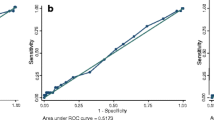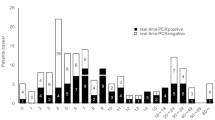Abstract
Community-acquiredMycoplasma pneumoniae pneumonia is a common disease which is usually diagnosed by serological methods. The objective of the present study was to understand the diagnostic significance and test characteristics of two different serological tests used to identify currentMycoplasma pneumoniae infection. Three hundred sixty-six patients who suffered from community-acquired pneumonia served as the study population. Six hundred ninety-four (328 paired and 38 unpaired) sera were examined for the presence of antibodies toMycoplasma pneumoniae with commercial kits based on two serological methods, microparticle agglutination and antibody-capture EIA. Agreement between the two kits was 85.2 % when individual sera were compared (Kappa=0.62) and 88.5 % when patients were compared (Kappa=0.69). The positive predictive value and the specificity for the identification of currentMycoplasma pneumoniae infection using a single acute-phase serum were 49.3 % and 86.9 %, respectively, for the microparticle agglutination method, compared to 91.3 % and 97.7 % for the antibody-capture EIA method (p<0.001). The negative predictive value and the sensitivity were 86.3 % and 48.1 % for the microparticle agglutination, not significantly different from the corresponding values of 86.5 % and 61.2 % for the antibody-capture EIA. It is concluded that the overall agreement between the two methods tested is good, but not perfect. The methods complement each other in the identification ofMycoplasma pneumoniae as the causative agent in patients with community-acquired pneumonia.
Similar content being viewed by others
References
Fang G, Fine M, Orloff J, Arisumi D, Yu VL, Kappor W: New and emerging etiologies for community-acquired pneumonia with implications for therapy. Medicine 1990, 69: 307–316.
Echevarria JM, Leon P, Balfagon P, Lopez JA, Fernandez MV: Diagnosis ofMycoplasma pneumoniae infection by microparticle agglutination and antibody-capture enzymeimmunoassay. European Journal of Clinical Microbiology & Infectious Diseases 1990, 9: 217–220.
Jalonen E, Paton JC, Koskela M, Kerttula Y, Leinonen M: Measurement of antibody responses to pneumolysin — a promising method for the presumptive aetiological diagnosis of pneumococcal pneumonia. Journal of Infection 1989, 19: 127–134.
Leinonen M, Syrjala H, Jalonen E, Kujala P, Herva E: Demonstration of pneumolysin antibodies in circulating immune complexes — a new diagnostic method for pneumococcal pneumonia. Serodiagnosis and Immunotherapy in Infectious Disease 1990, 4: 451–458.
Barker CE, Sillis M, Wreghitt TG: Evaluation of Serodia Myco II particle agglutination test for detectingMycoplasma pneumoniae antibody: comparison with μ-capture ELISA and indirect immunofluorescence. Journal of Clinical Pathology 1990, 43: 163–165.
Lee SH, Charoenting S, Brennan T, Markowski M, Mayo DR: Comparative studies of three serological methods for the measurement ofMycoplasma pneumoniae antibodies. American Journal of Clinical Pathology 1989, 92: 342–347.
Cimolai N, Mah D, Thomas E, Middleton PJ: Rapid immunoblot method for diagnosis of acuteMycoplasma pneumoniae infection. European Journal of Clinical Microbiology & Infectious Diseases 1990, 9: 223–226.
Caia WK, Spence L, Dunkley L, Bradbury W: Development of urease conjugated enzyme-linked immunosorbent assays (ELISA) for the detection of IgM and IgG antibodies againstMycoplasma pneumoniae in human sera. Diagnostic Microbiology and Infectious Disease 1988, 11: 101–107.
Ponka A, Ponka T, Sarna S, Penttinen K: Questionable specificity of lipid antigen inMycoplasma pneumoniae CF test in patients with extrapulmonary manifestations. Journal of Infection 1981, 3: 332–338.
Samra Z, Gadba R: Diagnosis ofMycoplasma pneumoniae infection by specific IgM antibodies using a new capture-enzyme-immunoassay. European Journal of Epidemiology 1993, 9: 97–99.
Sillis M: The limitations of IgM assays in the serological diagnosis ofMycoplasma pneumoniae infection. Journal of Medical Microbiology 1990, 33: 253–258.
Aubert G, Pozzetto B, Gaudin OG, Hafid J, Mbida AD, Ros A: Evaluation of five commercial tests: complement fixation, microparticle agglutination, indirect immunofluorescence, enzyme-linked immunosorbent assay and latex agglutination, in comparison to immunoblotting forMycoplasma pneumoniae serology. Annales de Biologie Clinique 1992, 50: 593–597.
Vloum SA, Jensen JS, Sondergard-Andersen J, Lind K: Enzyme immunoassay for detection of immunoglobulin M (IgM) and IgG antibodies toMycoplasma pneumoniae. Journal of Clinical Microbiology 1992, 30: 1198–1204.
Author information
Authors and Affiliations
Rights and permissions
About this article
Cite this article
Lieberman, D., Lieberman, D., Horowitz, S. et al. Microparticle agglutination versus antibody-capture enzyme immunoassay for diagnosis of community-acquiredMycoplasma pneumoniae pneumonia. Eur. J. Clin. Microbiol. Infect. Dis. 14, 577–584 (1995). https://doi.org/10.1007/BF01690728
Issue Date:
DOI: https://doi.org/10.1007/BF01690728




